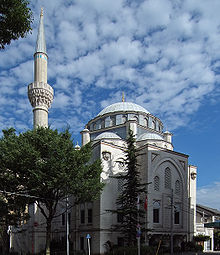Tokyo Camii
Tokyo Camii ( Japanese 東京 ジ ャ ー ミ イ , Tōkyō-jāmii ; also Tokyo Mosque ( 東京 モ ス ク , Tōkyō-mosuku ); full name: 東京 ジ ャ ー ミ イ ・ ト ル コ 文化 セ ン タ ー , as much as -b · ー , as -b "Tokyo Mosque & Turkish Cultural Center") is a mosque with an attached Turkish cultural center in the Japanese capital Tokyo . It is located in the Ōyama-chō ( 大 山 町 ) district of the Shibuya district , near the Yoyogi-Uehara train station .
The mosque was together with a school on May 12, 1938 ( Mawlid of the year) by the municipality "Mahalle-i İslamiye", Bashkir and Kazan - Tatar emigrants from Russia after the October Revolution , under Abdurresid Ibrahim (the first Imam of the mosque ) and Abdülhay Kurban Ali in the Yoyogi-Uehara ( 代 々 木 上原 ) district of Shibuya. At the opening ceremony, high-ranking military and politicians from Japan (including the founder of the ultranationalist Gen'yōsha Tōyama Mitsuru and Admiral Ogasawara Naganari ) and abroad were present.
In 1986 the mosque was demolished due to severe structural damage. Under the auspices of Diyanet İşleri Başkanlığı , a new building was started in 1998, which was completed in 2000 and the cost of which was around 1.5 billion yen . The architect of the new building was Muharrem Hilmi Senalp. The new building is based on the ornamentation of Ottoman sacred architecture . This time the inauguration ceremony took place on June 30, 2000, at which the Turkish ambassador to Japan, Yaman Başkut, gave a speech. Minister of State Fikret Ünlü and the Chairman of the Presidium for Religious Affairs, Mehmet Nuri Yılmaz, were also present at the opening ceremony .
During a visit to the mosque in 2003, the then President of the Turkish Parliament, Bülent Arınç , said: "I hope that those who come and see this will convert to the true religion." A day later, he declared that he had been misunderstood. He never asked the Japanese to convert. In 2004, Prime Minister Recep Tayyip Erdoğan visited Tokyo Camii as part of a state visit. He was accompanied by the then Minister of State Ali Babacan , the ministers for health and tourism, a group of MPs and the Turkish ambassador in Tokyo, Solmaz Ünaydın.
Web links
- Official website - Japanese and English
- Information and pictures - Japanese
- Press release of the construction company Kajima on the new building 2000 - English
Individual evidence
- ↑ Selçuk Esenbel: “ Japan's Global Claim to Asia and the World of Islam: Transnational Nationalism and World Power, 1900-1945 ( Memento December 5, 2004 in the Internet Archive )”, in: The American Historical Review , Vol. 109, No. . October 4, 2004.
- ↑ “ Muslims raise funds for Tokyo Mosque project ( Memento of July 8, 2012 in the web archive archive.today )”, in: Japan Policy & Politics , September 21, 1998.
- ↑ Archived copy ( Memento of the original from January 27, 2008 in the Internet Archive ) Info: The archive link was inserted automatically and has not yet been checked. Please check the original and archive link according to the instructions and then remove this notice.
- ^ “ New Tokyo Mosque opens, ” in: The Japan Times , July 1, 2000.
- ↑ Report from the Turkish Embassy in Japan ( Memento of the original from March 2, 2008 in the Internet Archive ) Info: The archive link was automatically inserted and not yet checked. Please check the original and archive link according to the instructions and then remove this notice. in Turkish.
- ↑ " Şintoist Japonları İslamiyete çağırdı ," in Milliyet on 4 June 2003 in Turkish.
- ↑ “ Arınç: Japonları İslamiyete çağırmadım ”, in: Radikal from June 5, 2003 in Turkish.
- ↑ Message from Diyanet İşleri Başkanlığı ( page no longer available , search in web archives ) Info: The link was automatically marked as defective. Please check the link according to the instructions and then remove this notice. in Turkish.
Coordinates: 35 ° 40 ′ 5.3 " N , 139 ° 40 ′ 35.4" E
